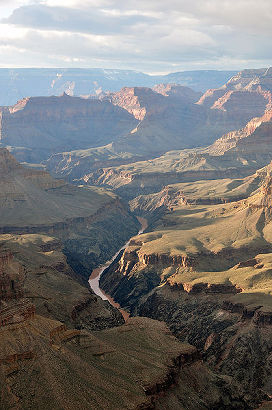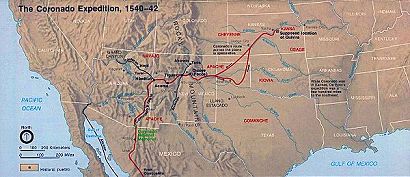|
Books by
Jeffery Robenalt
|
|
|
When
Spanish castaway, Cabeza
de Vaca, arrived in Mexico City after his escape from slavery
and epic, eight-year journey across the interior of Texas and Northern
Mexico, he met with the Viceroy of New Spain, Antonio de Mendoza.
During the meeting with Mendoza, De Vaca described his stay with
the Jumano, a tribe of Native Americans who lived west of the Big
Bend area along the Rio Grande. According to De
Vaca, the Jumano told him of seven fabulous cities of gold,
known in Spanish legend as Cibola, that lay somewhere to the north
of their land.
|
|
|
Viceroy
Antonio de Mendoza
Photo www.wikipedia.org |
Spanish conquistadors
had already discovered yet uncounted riches among the Native Americans
of Mexico and Peru. Could the tale of the seven cities of gold also
be true? Before he risked the expense of outfitting a full scale expedition,
Viceroy Mendoza wisely decided to dispatch Friar Marcos de Niza
and Estavancio, a former Moorish slave and survivor of Cabeza
de Vaca’s journey, north to confirm the existence of the legendary
Cibola.
After the small expedition reached the area of present-day Arizona,
Friar Marcos sent Estavancio ahead to scout into the land of the Zuni.
The former slave’s instructions were to send a runner back with a
large cross if he found Cibola and a small cross if the story proved
to be untrue. Several days later a runner returned bearing a large
cross.
Friar Marcos hurried north to join Estavancio; however, as he neared
the land of the Zuni, he learned that the suspicious Native Americans
killed the former slave. In the far distance, the Friar saw the sun
reflecting on a Zuni pueblo, which he mistook for the glint of gold.
Fearing for his life if he approached any nearer, Marcos returned
to Mexico City. There the Friar claimed that although he had not set
foot in Cibola, he had seen a golden city standing high on a hill
and the Pacific Ocean off to the west. |
|
|
Coronado
as depicted at the Deaf Smith County Historical Museum in Hereford,
Texas
Photo www.wikipedia.org |
Based
on the report of Friar Marcos, Viceroy Mendoza commissioned Francisco
Vasquez de Coronado, the governor of the province of Nueva Galicia,
to lead an expedition in search of Cibola. Coronado’s
expedition, including 250 cavalry, 80 infantry, 1000 Indians, several
priests, and thousands of horses, cattle, and sheep, departed from
Culiacan, the capital of Nueva Galicia, in the spring of 1540.
Moving ahead of the main body of the expedition with a small advance
force, Coronado reached the Zuni pueblo of Hawikuh, in July.
Though he arrived with peaceful intentions, fighting broke out almost
immediately. The Spanish, equipped with muskets, armor, and horses,
easily defeated the Zuni and moved into the pueblo. An expedition
sent north to deal with the pueblos of the Hopi was equally
successful, but neither the Zuni nor the Hopi possessed the precious
metals or gems Coronado was searching for. Thus, while the Spanish
had little trouble dealing with the military aspect of the expedition,
the economic results of the campaign were disappointing.
The main body of the expedition arrived soon after the problems with
the Zuni and Hopi were settled, and Coronado decided to winter in
the Tiwa village of Tiguex, located in the Rio Grande valley,
not far from present-day Albuquerque. In the beginning, relations
with the natives were friendly, but before long, pressures on the
food supply, brought on by the unexpected Spanish occupation, and
several sexual assaults on Native American women antagonized the Tiwa
and led them to launch an attack.
Believing that it was necessary to crush the Tiwa as an example to
discourage the aggression of other tribes, Coronado retaliated without
mercy. He sacked the biggest Tiwa settlement, burning thirty Native
Americans at the stake, and then captured the large and well-defended
pueblo of Moho in March 1541. After the decisive victory, the survivors
of the attack were enslaved and distributed among his men as tribute.
|
 |
Grand Canyon
Photo Wikimedia Commons |
|
Refusing
to return to Mexico City empty-handed, Francisco Coronado split
up his expedition. The conquistador sent one group west to search
far across the present-day state of New Mexico and into Arizona.
They became the first Europeans to view the majestic Grand Canyon.
On April 23, 1541, Coronado led another group east, based on the
advice of an Eastern Plains Native American the Spaniards called
“El Turco,” or the Turk.
The Turk promised to lead the expedition to a golden land the Native
Americans referred to as Quivera. He first led the expedition onto
a vast and featureless steppe the Spaniards named the Llano
Estacado, or Staked Plain, passing through the present-day
Texas towns of Hereford
and Canadian.
The Spanish were amazed at the number of buffalo that inhabited
the plains.
In his report to King Carlos, Coronado said “After nine day’s march
I reached some plains, so vast that I did not find their limit anywhere
that I went, although I traveled … for more than 300 leagues and
found such a quantity of cows … that it is impossible to number
them …” The Spanish encountered a tribe of Native Americans on the
plains they called the Querechos, nomads who survived by
following the huge buffalo herds. Most authorities agree the Querechos
were the Apache.
|
 |
|
Continuing to
follow El Turco to the southeast, the expedition dropped
off the table top of the Llano Estacado and entered the canyon
country of the Caprock. There the Spaniards met with another
group of Native Americans, the Teyas, who were enemies of the Querechos.
Like the Querechos, the Teyas were also numerous and survived by
hunting the buffalo, but the canyons they inhabited had trees and
flowing streams, and they could freely forage for roots, nuts, and
berries. Authorities vary as to which historical Native American
group the Teyas belonged, but most believe they were related to
the Wichita. While in the canyon country, the expedition was struck
by a violent Texas thunderstorm complete with high winds and hail
stones that shattered pottery, shredded tents, and wounded many
of the horses.
|
Coronado Sets
Out to the North by Frederic Remington
Photo sagaofatexasranger.com |
|
When the Teyas
learned Coronado was searching for Quivera, they informed him he
was going in the wrong direction. Quivera, they said, lay much further
to the north. Following their advice, the expedition eventually
reached Palo
Duro Canyon, near present-day Amarillo.
By this time, Coronado began to suspect the Turk was not telling
the truth, so he ordered most of his men back to Tiguex and continued
his journey as a reconnaissance rather than a mission of conquest,
with only forty soldiers and priests, and an unknown number of Native
American warriors, servants, and guides.
Thirty days later, the smaller force struck what is today the Arkansas
River, probably a few miles east of present-day Dodge City, Kansas.
Coronado followed the Arkansas northeast for three days until he
met a buffalo hunting party from Quivera, but when the friendly
Native Americans took him to their villages his worst fears were
confirmed. Instead of golden cities, the Spanish conquistador found
only straw-thatched dwellings and ripening fields of corn, beans,
and squash. Coronado spent more than three weeks in Quivera, questioning
the Native Americans about the existence of richer kingdoms, but
his efforts were in vain. Severely disappointed with the outcome
of his search, he ordered the Turk garroted for lying and returned
to New Mexico.
After wintering once again in the Rio Grande valley, Coronado led
his men back to Mexico
in 1542. Upon his return, he faced charges of having violated the
New Laws concerning Native Americans by abusing them and confiscating
their property. The conquistador was eventually cleared of these
charges, but he lost his position as governor of Nueva Galicia in
1544 and was forced into bankruptcy. Coronado retired to Mexico
City, where he died on July 21, 1554.
|
 |
The
Coronado Expedition, 1540-42
Photo www.wikipedia.org |
Though
unsuccessful, Francisco Coronado’s search for the fabled Cibola had
far reaching consequences for the both the Spanish and the Pueblo
Indians. The expedition demonstrated to the Pueblos that the Spanish
were capable of retaliating in a vicious manner for any transgression,
and, more importantly, that the Europeans enjoyed a decided military
advantage due to their horses, firearms, and metal weapons and armor.
For the Spanish, Coronado’s wandering search of the Southwest, coupled
with Hernando de Soto’s nearly simultaneous unsuccessful search of
the Southeast, put an end to the belief that the North American continent
contained a rich and easily plundered Native American civilization
like the Aztecs or the Incas. As a result, Spain lost interest in
the region for nearly sixty years, until the French exploration of
Eastern Texas led by Rene-Robert de La Salle convinced the Spanish
to send Juan de Onate to establish the New Mexico colony of Santa
Fe in 1598.
© Jeffery
Robenalt
"A Glimpse of Texas Past"
June 1,
2011 Column
jeffrobenalt@yahoo.com
About Jeffery Robenalt
|
|
|
